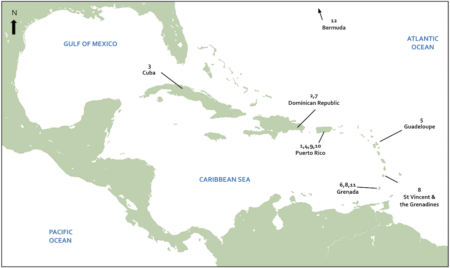 Volume 34 of the Journal of Caribbean Ornithology (JCO) presents a wide spread of original contributions, from methodical surveys of seabirds and landbirds, to the documentation of rarely seen behaviors, that all add to the knowledge of the Caribbean avifauna. Despite ongoing challenges posed by the Covid-19 pandemic, our team of editors, reviewers, other JCO staff, and valued authors worked together to provide all these publications to the scientific and conservation communities around the Caribbean. Thank you all! Behind the scenes, Dr. Stefan Gleissberg has taken over the reins as JCO Managing Editor, learning the ropes from Justin Proctor, who continues to work on behalf of JCO as BirdsCaribbean’s Vice President. See below short summaries of the 12 regular articles reporting from 7 island territories. Free access to the journal’s entire content also includes 4 book reviews and the annual review of ornithological literature from the Caribbean by Dr. Steven Latta. Please take some time to enjoy all of Volume 34. If you enjoyed reading an article, please send the authors or the Managing Editor a quick email letting them know. — Joseph M. Wunderle, Jr., JCO Editor-in-Chief | jmwunderle@gmail.com — Stefan Gleissberg, JCO Managing Editor | stefan.gleissberg@birdscaribbean.org
Volume 34 of the Journal of Caribbean Ornithology (JCO) presents a wide spread of original contributions, from methodical surveys of seabirds and landbirds, to the documentation of rarely seen behaviors, that all add to the knowledge of the Caribbean avifauna. Despite ongoing challenges posed by the Covid-19 pandemic, our team of editors, reviewers, other JCO staff, and valued authors worked together to provide all these publications to the scientific and conservation communities around the Caribbean. Thank you all! Behind the scenes, Dr. Stefan Gleissberg has taken over the reins as JCO Managing Editor, learning the ropes from Justin Proctor, who continues to work on behalf of JCO as BirdsCaribbean’s Vice President. See below short summaries of the 12 regular articles reporting from 7 island territories. Free access to the journal’s entire content also includes 4 book reviews and the annual review of ornithological literature from the Caribbean by Dr. Steven Latta. Please take some time to enjoy all of Volume 34. If you enjoyed reading an article, please send the authors or the Managing Editor a quick email letting them know. — Joseph M. Wunderle, Jr., JCO Editor-in-Chief | jmwunderle@gmail.com — Stefan Gleissberg, JCO Managing Editor | stefan.gleissberg@birdscaribbean.org

RESEARCH ARTICLES AND NOTES
-
Status of seabirds, habitat, and invasive species in the Cordillera Reef Nature Reserve, Puerto Rico
Luis A. Ramos-Vázquez, Nahíra Arocho-Hernández, Cielo Figuerola-Hernández, José L. Herrera-Giraldo, and Jan P. Zegarra-Vila The Cordillera Reef Nature Reserve, an island chain just off the northeast coast of Puerto Rico, provides critical breeding habitat for seabirds in the Caribbean; however, little is known about the seabird populations, and the threats they face, on these islands. To address this, Ramos-Vásquez et al. conducted seabird surveys and an invasive animal detection assessment across the nature reserve, providing updated information that highlights the importance of the reserve for seabird colonies and the need for effective, well-planned invasive species management.
Vivan M. Lee, Alejandra Pérez, Olive Onyekwelu, Jordan M. Chan, Dominic E. Cannady-Lindner, Alexander A. Levitskiy, María Teresa Reinoso-Pérez, and André A. Dhondt Are Broad-billed Todies territorial during the non-breeding season? To answer this, Lee et al. conducted playback experiments in native scrub forest in the Dominican Republic to assess responses to three distinct Broad-billed Tody vocalizations. Todies responded more rapidly and intensely to song playbacks compared to other sounds, suggesting that they aggressively defend their habitats even during the non-breeding season.
Karina Velazco Pérez, Felix Noel Estrada Piñero, Hiram González Alonso, and Alina Pérez Hernández The Ovenbird (Seiurus aurocapilla) is a common winter resident and one of the most abundant migratory species in the Cuban Archipelago; however, little is known about the species’ migration dynamics. In this study, Velazco Pérez et al. conducted mist-net surveys on the Guanahacabibes peninsula to establish a baseline for both the physiological and ecological characteristics of the Ovenbird’s autumnal arrival in Cuba.
Ted Gilliland It’s a bird-eat-bird world! Pearly-eyed Thrashers (Margarops fuscatus), known for their aggressive interspecific interactions, are suspected predators of other resident birds, including Bananaquits (Coereba flaveola). Northern Parulas (Setophaga americana) are neotropical migrants that regularly mob predators in defense and to gain information. In this research note, Gilliland documents a chance observation in Puerto Rico of Northern Parulas mobbing a Pearly-eyed Thrasher, a behavior with implications for social learning and future predator avoidance.
Pascal Villard, Alain Ferchal, Philippe Feldmann, Claudie Pavis, and Christophe Bonenfant Organochlorine insecticides can have lasting and devastating effects on bird populations, by altering bird behaviour and reproductive success. Almost three decades after the cessation of its use in Guadeloupe, the organochlorine “chlordecone” persists in the soils and waterways of the island. The Ringed Kingfisher (Megaceryle torquata) is one of the species likely affected by this persistent pollutant, and in this paper, Villard et al. explore the possible links between remnant chlordecone pollution and habitat selection by Ringed Kingfishers.
Alexandra Heathcote, Paulson Des Brisay, Christopher De Ruyck, Paula Grieef, and Nicola Koper How are birds on small, species-poor islands like Grenada different from their neighboring conspecifics? Lower species diversity on islands can lead to more generalist behaviour in birds, where these island populations live in more varied habitats and eat a more varied diet than elsewhere. This phenomenon is called “ecological release”. In this paper, Heathcote et al. explore the morphological effects of ecological release on four common Grenada bird species, comparing them to their neighbors throughout the Caribbean Basin and providing evidence that these Grenadian birds are perhaps even more different than we thought.
Pedro M. Alarcón-Elbal, Holly M. Garrod, Spencer C. Schubert, and Alonso Santos Murgas Louse flies (Hippoboscidae) are obligate parasites that often live on birds. The louse fly Ornithoctona erythrocephala has been documented with avian hosts of all sizes throughout the Caribbean, though it is previously unreported on tanagers (Thraupidae). In this research note, Alarcón-Elbal et al. describe the first record of this fly parasitizing the Black-faced Grassquit (Melanospiza bicolor) and Green Heron (Butorides virescens) in the Dominican Republic, an observation with implications for avian health and the direction of ornithological and entomological research in the region.
Juliana Coffey and Natalia Collier The Grenadine islands are one of the remaining hotspots for breeding seabird populations in the Caribbean. There, as elsewhere, introduced mammals threaten the survival of seabirds through predation and habitat degradation. In this paper, Coffey and Collier present the most thorough inventory ever compiled of invasive mammals throughout the Grenadines, a critical first step to conservation planning for mammal eradication and habitat restoration.
Jean P. González-Crespo and Alberto R. Puente-Rolón Blackbirds (Icteridae) have been known to engage in some cutthroat nesting behaviours, such as brood parasitism (e.g., the infamous Shiny Cowbird [Molothrus bonariensis]) and nest piracy or usurpation. Nest usurpation involves stealing another individual’s nest for breeding, and the usurper will forcefully remove all obstacles in its way, including any unfledged nestlings. In this research note, González-Crespo and Puente-Rolón present the first record of nest usurpation by the Yellow-shouldered Blackbird (Agelaius xanthomus) in Puerto Rico, with implications for the reproductive success of this endemic and Endangered species.
Cielo E. Figuerola-Hernández, Rickard S. Toomey III, Patricia Kambesis, José L. Herrera-Giraldo, and Nick D. Holmes Invasive mammals pose a threat to seabird populations throughout the Caribbean, and Mona Island—off the coast of Puerto Rico—is no exception. The Audubon’s Shearwater (Puffinus lherminieri) and the Bridled Tern (Onychoprion anaethetus) are two cave-breeding seabirds whose habitat is limited by the presence of rats, cats, and other invasive mammals. In this research note, Figuerola-Hernández et al. present evidence of breeding of these two species in caves on Mona Island, the first documented nests in over eight decades.
Eleanor S. Devenish-Nelson and Howard P. Nelson Resident landbirds are an ubiquitous yet unique part of the avifauna in the Caribbean, but they are relatively understudied. Several of these species are also endemic to the region, making the documentation and monitoring of their populations all the more important. On Grenada, there are approximately 36 resident landbird species, of which at least 25% are regionally endemic. In this paper, Devenish-Nelson and Nelson present abundance and density estimates for these species, from one of the first island-wide surveys since the 1980s.
Andrew le F. Dobson, Andrea Webb, Ingela Perrson, Richard Brewer, Luke Foster, and Miguel A. Mejías In this research note from Bermuda, Dobson et al. document a vagrant Mountain Bluebird (Sialia currucoides), a western North American species discovered by local birders among Eastern Bluebirds (Sialia sialis). The observation represents the first record of the species outside the continent.
BOOK REVIEWS
Birds of Cuba: A Photographic Guide
Book author: Arturo Kirkconnell, Patricia E. Bradley, and Yves-Jacques Rey-Millet Book review by: Steven C. Latta
The Birds of Cuba: An Annotated Checklist
Book author: Arturo Kirkconnell, Guy M. Kirwan, Orlando H. Garrido, Andy D. Mitchell, and James W. Wiley Book review by: Steven C. Latta
Looking for the Ivory-billed Woodpecker in eastern Cuba
Book author: Alberto R. Estrada Book review by: Mark Michaels
The root of the Antilles: a history of the Todidae family
Book authors: José González Díaz and Felisa Collazo Torres Book review by: Thomas W. Sherry
RECENT ORNITHOLOGICAL LITERATURE (ROL) FROM THE CARIBBEAN
Recent ornithological literature from the Caribbean – 2021
Steven Latta The annual compilation of the most important articles that appeared elsewhere, annotated by Steve Latta. Article by: (1) Zoya Buckmire – Copy Editor for the Journal of Caribbean Ornithology; (2) Joe Wunderle – Editor-in-Chief for the Journal of Caribbean Ornithology (3) Justin Proctor – Vice President of BirdsCaribbean (4) Stefan Gleissberg – Managing and Production Editor for the Journal of Caribbean Ornithology The Journal of Caribbean Ornithology relies on donations to keep all of our publications free and open-access. Support our non-profit mission and give a voice to Caribbean ornithologists and their work by becoming a supporter of JCO.
